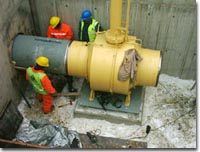 The Acoustic Emission (AE) technique is based on the detection of the high frequency component of naturally occurring stress waves (or structure borne elastic waves). There was a time when AE was regarded only as a means of monitoring defect growth in stressed materials and structures. Despite numerous instances of its successful application to machinery condition monitoring since the 1960
Thermography, Lubrication Management & Analysis and Vibration Analysis as specified in ISO 18436. Furthermore, AE has its own CM standard ISO 22096 (Condition monitoring and diagnostics of machines – Acoustic emission) and ISO traceable certification of CM practitioners is available to Levels 1, 2 & 3.
The Acoustic Emission (AE) technique is based on the detection of the high frequency component of naturally occurring stress waves (or structure borne elastic waves). There was a time when AE was regarded only as a means of monitoring defect growth in stressed materials and structures. Despite numerous instances of its successful application to machinery condition monitoring since the 1960
Thermography, Lubrication Management & Analysis and Vibration Analysis as specified in ISO 18436. Furthermore, AE has its own CM standard ISO 22096 (Condition monitoring and diagnostics of machines – Acoustic emission) and ISO traceable certification of CM practitioners is available to Levels 1, 2 & 3.Whilst these developments represent the culmination of much hard work undertaken by key AE practitioners over recent years they have only been made possible by the unique attributes of AE in the CM role which deliver important practical benefits for industrial use :-
a) A high Signal to Noise Ratio (SNR), which means that the presence of a small fault gives rise to a large change in the detected signal, giving AE the following inherent benefits :-
• sensitive to faults at an early stage
• the presence of a fault can be detected without having to first do a frequency analysis
• very slowly moving machinery can be monitored
• a broad range of fault types can be simultaneously detected
b) It is based on the omni-directional detection of propagating high frequency waves, which simplifies AE detection and sensor installation in the following ways :-
• there is no need for sensors to be mounted in specific orientations
• there is no need for sensors to be mounted in the same plane as bearings
• it is not necessary to consider the possibility of the sensor being mounted on a node or anti-node on the machine surface
• cross-talk or interference from adjacent machinery is seldom an issue
• it can be applied in noisy and high vibration environments
The many benefits of AE listed above have underpinned its success as a routine CM method to assist maintenance personnel and not surprisingly it is incorporated in both portable CM instruments and permanently installed monitoring systems.
A key to the continued growth of permanently installed monitoring systems in industry is ease of integration into existing shop floor monitoring and control systems. Because of the high frequency nature of AE sensors, in the past this has necessitated the use of an AE instrument to pre-process the signals. However as an example of the growing maturity of AE technology in the CM role, recent development have led to smart AE sensors (such as the MHC-DS1 - see photo) in which the entire AE instrument is integrated within the sensor itself. Such a smart sensor approach overcomes the difficulties for the end user of having to deal with high frequency signals and coaxial cables but instead has pre-processed DC and switched outputs on twisted pair cables for direct connection to PLC, SCADA etc..
In terms of machinery protection (i.e. detecting gross mechanical failures as they happen) rms responding and switched output Vibration sensors are a familiar site on the shop floor but such sensors are not suited to the CM role. This is because the benefits of CM, maximising machine utilisation and minimising maintenance costs, rely upon an early warning of degradation in order to allow the timely planning of appropriate service and maintenance activities. It is in this CM role that smart AE sensors look set to play an important part as a natural compliment to machinery protection sensors; in the foreseeable future they may even become as ubiquitous.

